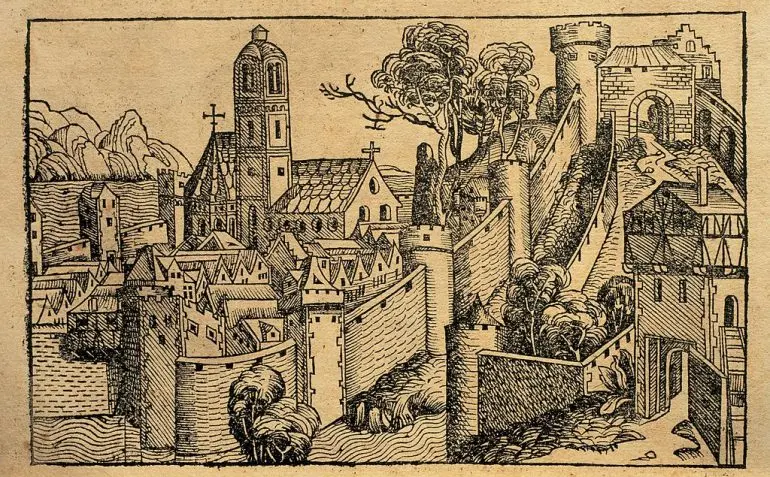The ancient Library of Alexandria, often romanticised as the greatest and most significant repository of human knowledge in the ancient world, stands as an enduring symbol of lost wisdom, but what happened to the Library of Alexandria?
This architectural marvel was not merely a collection of books, but a sprawling complex, making it the epicentre of academic and cultural life in Alexandria. The sheer scale of its collection led many to believe it was – at the time – the greatest accumulation of human knowledge ever assembled.
The destruction of the Library of Alexandria is not just about the loss of a building or the disappearance of papyrus scrolls. It represents the demise of cultural and intellectual heritage. There are various accounts and theories about how and when the library was lost, with each version differing in details and suspects. This uncertainty has transformed the library’s end into a baffling historical whodunnit.
Who left the Library of Alexandria burning? Was it an accident, or were there more sinister motives for its destruction?
These, and many other questions add to the intrigue surrounding the burning of the Library of Alexandria. Let’s take a trip back to ancient Egypt in an effort to shed light on this peculiarly perplexing pyre of papyrus.
The Library of Alexandria

A 19th century illustration of scholars in the Library of Alexandria. (Credit: clu via Getty Images)
While its reputation as an intellectual centre of the ancient world is undisputed, the exact details about the library’s founding and early development are pretty vague. They’re pieced together using various historical accounts, including the Letter of Aristeas, written in the late third or early second century BC.
It’s generally agreed that the library was established in the early third century BC in Alexandria, Egypt. The founding of the library is commonly attributed to Ptolemy I Soter, a general under Alexander the Great who became a Pharaoh of Egypt, or to his son, Ptolemy II Philadelphus. These rulers were part of the Ptolemaic regime, a Macedonian Greek dynasty which ruled in Egypt following Alexander the Great’s conquest and subsequent death in 323 BC.
The library was part of a larger research institution called the Mouseion, which was dedicated to the Muses, the Greek goddesses of the arts and sciences. The Ptolemies’ ambition was to make Alexandria a centre of learning and culture, not just for Egypt but for the entire world. They’re said to have actively sought to collect all the world’s knowledge, and scholars from all over the Mediterranean world were invited to study and contribute to the library’s collection.
Such was the Ptolemies’ insatiable thirst for knowledge, one story often told was that Ptolemy III decreed every ship that docked in the port of Alexandria surrender their scrolls and manuscripts to the local authorities. Copies would be made and returned to their owners, while the originals would become part of the library’s collection.
Contemporary and later sources have reported that the number of papyrus scrolls contained in the library varied from a lower estimate of 40,000 to an upper estimate of half a million or more. Some quoted figures put the number as high as 700,000, which were either written in or translated into Greek, the lingua franca of the Hellenistic world. These scrolls covered a vast range of subjects, including philosophy, science, medicine, literature, and history, making the Library of Alexandria a hub of ancient knowledge and learning.
At its height, it was said to be one of the world’s great architectural and cultural icons, containing works by some of history’s greatest writers and thinkers including Herodotus, Plato, Homer and Socrates. So what happened to the Library of Alexandria?
The Burning of the Library of Alexandria

The Burning of the Library of Alexandria, 1876. (Credit: Fine Art Images/Heritage Images via Getty Images)
The destruction of the Library of Alexandria is one of the most enduring mysteries of the ancient world. Over the centuries, several theories have emerged regarding how and why it was destroyed.
The lack of contemporary records means much of what we know is based on writings that came centuries later, leading to a mix of historical conjecture and legend. The prevailing theories often implicate notable historical figures, each with different motives.
Julius Caesar | Approx. 48 - 47 BC

Caesar Defeats the Troops of Pompey, artist Gerard Peemans (Credit: Heritage Art/Heritage Images via Getty Images)
One of the earliest and most commonly cited suspects is Roman dictator Julius Caesar. During his civil war with Pompey, Caesar was besieged in Alexandria. In 48-47 BC, he set fire to his own – or as other versions suggest, enemy ships – to clear the wharves. This fire is said to have spread from the ships to parts of the city, which may have resulted in the Library of Alexandria burning accidentally.
Greek historian Plutarch wrote of the incident, ‘Caesar was forced to repel the danger using fire, which spread from the dockyards and destroyed the Great Library.’ Caesar’s involvement, however indirectly, was also mentioned later in Ab Urbe Condita, Livy’s monumental history of Rome, and also by Roman historian Dio Cassius.
Some scholars suggest that if the library was damaged during this incident, it was likely not completely destroyed, as there are references to the library in works that postdate Caesar’s campaign in Alexandria.
Theophilus of Alexandria | Approx. 391 AD

The ruins of the Serapeum of Alexandria (Credit: Amir MAKAR / AFP via Getty Images)
Theophilus was the Patriarch of Alexandria and a zealous religious reformer. He’s most commonly associated with the destruction of pagan temples in the city.
Some accounts suggest that during his campaign against paganism, he may have targeted the Serapeum of Alexandria, which was a temple that may have housed part of the library’s collection, perhaps as many as 42,000 scrolls. However, the extent to which the Serapeum functioned as a ‘daughter library’ to the main Library of Alexandria, and Theophilus’ involvement with the burning of the Library of Alexandria, is unclear.
In addition, there’s no evidence that the library still existed in the fourth century and there are no sources from this time, or later, that mention the destruction of the Library of Alexandria.
Caliph Omar | Approx. 642 AD

The burning of the library of Alexandria (Credit: Culture Club / Contributor via Getty Images)
A popular mediaeval story attributes the final burning of the Library of Alexandria to Caliph Omar during the Muslim conquest of Alexandria under Amr ibn al-As. According to this story, Omar ordered the burning of the library’s books, using them as fuel for the city’s estimated 4,000 bathhouses. One source, written three hundred years later by Gregory Bar Hebraeus, suggested there were so many scrolls, the bathhouses were continually heated for six months.
This account, however, is widely considered apocryphal by modern historians and is thought to have originated centuries after the conquest, with no mention of such a cataclysmic event by contemporary chroniclers such as John of Nikiou or Sophronius, the Patriarch of Jerusalem.
The Gradual Decline of the Library of Alexandria

Scholars in the library of Alexandria (Credit: Leemage/Corbis via Getty Images)
The gradual decline theory of the Library of Alexandria suggests that its demise was not the result of a single catastrophic event, but rather a prolonged period of decline over several centuries.
This decline could have started as early as 145 BC with the expulsion of intellectuals from Alexandria, and continued due to a lack of funding and support during the Roman period.
In this view, the library’s eventual disappearance would have likely resulted from a combination of these factors, including potential damage from conflicts like the Palmyrene invasion and an imperial counterattack around 270-275 AD.
An Ongoing Mystery

An engraving of The Ruins of Ptolemy Library in Alexandria, 1804, by Luigi Mayer (Credit: DeAgostini via Getty Images)
Each of these theories about who destroyed the Library of Alexandria reflects different historical contexts and motivations.
In Caesar’s case, the destruction would have been unintentional, a collateral damage of war. For Theophilus, it would have been an act of zealotry against paganism. In the case of Caliph Omar, the story, though likely fictional, reflects religious tensions during the Middle Ages.
It’s important to note that these theories are not mutually exclusive and that the library may have suffered multiple incidents of damage over time, contributing to its eventual decline and disappearance. The true story of the destruction of the Library of Alexandria remains elusive, compounded by the passage of time and the scarcity of direct historical records.
The Enduring Enigma of the Library of Alexandria

15th century engraving depicting the city of Alexandria (Credit: Prisma/Universal Images Group via Getty Images)
The burning of the Library of Alexandria remains one of history’s great mysteries, encapsulating the fragility of human knowledge against the backdrop of political, religious, and military upheavals.
The library’s end, shrouded in historical ambiguity, continues to intrigue and baffle scholars, serving as a testament to the unstoppable march of time and the transformative tides of human history.
While the answer to the question ‘what happened to the Library of Alexandria’ might forever be elusive, its enduring allure and the lessons learned from its story are reminders of the importance of safeguarding knowledge and cultural heritage for future generations.












